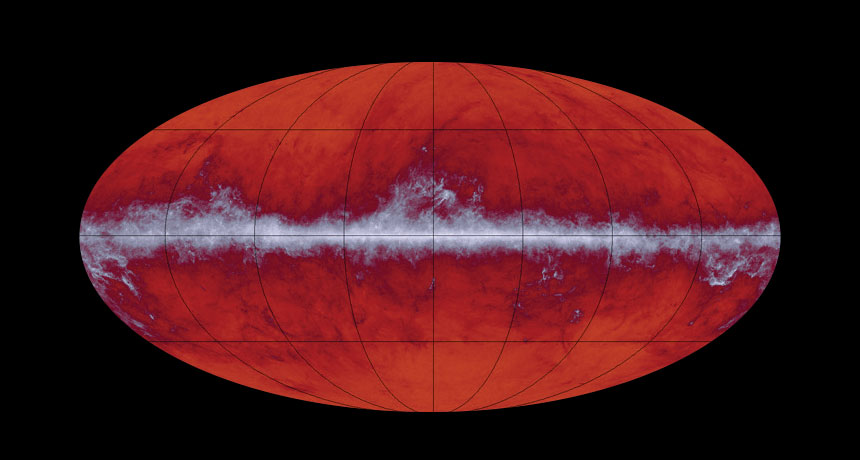Hints of Oort clouds around other stars may lurk in the universe’s first light
Searching the cosmic microwave background could reveal other giant spheres of icy debris

HIDDEN TREASURES This map of the cosmic microwave background taken by the Planck satellite could also hide signs of exo-Oort clouds — planetary graveyards surrounding other stars.
Planck/ESA and NASA, IPAC Infrared Science Archive
- More than 2 years ago
A thick sphere of icy debris known as the Oort cloud shrouds the solar system. Other star systems may harbor similar icy reservoirs, and those clouds may be visible in the universe’s oldest light, researchers report.
Astronomer Eric Baxter of the University of Pennsylvania and colleagues looked for evidence of such exo-Oort clouds in maps of the cosmic microwave background, the cool cosmic glow of the first light released after the Big Bang, roughly 13.8 billion years ago. No exo-Oort clouds have been spotted yet, but the technique looks promising, the team reports November 2 in the Astronomical Journal. Finding exo-Oort clouds could help shed light on how other solar systems — and perhaps even our own — formed and evolved.
The Oort cloud is thought to be a planetary graveyard stretching between about 1,000 and 100,000 times as far from the sun as Earth. Scientist think that this reservoir of trillions of icy objects formed early in the solar system’s history, when violent movements of the giant planets as they took shape tossed smaller objects outward. Every so often, one of those frozen planetary fossils dives back in toward the sun and is visible as a comet (SN: 11/16/13, p. 14).
But it’s difficult to observe the Oort cloud directly from within it. Despite a lot of circumstantial evidence for the Oort cloud’s existence, no one has ever seen it.
Ironically, exo-Oort clouds might be easier to spot, Baxter and colleagues thought. The objects in an exo-Oort cloud wouldn’t reflect enough starlight to be seen directly, but they would absorb starlight and radiate it back out into space as heat. For the sun’s Oort cloud, that heat signal would be smeared evenly across the entire sky from Earth’s perspective. But an exo-Oort cloud’s warmth would be limited to a tiny region around its star.
Baxter and colleagues calculated that the expected temperature of an exo-Oort cloud should be about –265° Celsius, or 10 kelvins. That’s right in range for experiments that detect the cosmic microwave background, or CMB, which is about 3 kelvins.
The team used data from the CMB-mapping Planck satellite to search for areas across the sky with the right temperature (SN Online: 7/24/18). Then, the researchers compared the results with the Gaia space telescope’s ultraprecise stellar map to see if those regions surrounded stars (SN: 5/26/18, p. 5).
Although the astronomers found some intriguing signals around several bright, nearby stars, it wasn’t enough to declare victory. “That’s pretty interesting, but we can’t definitively say that it’s from an Oort cloud or not,” Baxter says.
Other ongoing CMB experiments with higher resolution, like those with the South Pole Telescope and the Atacama Cosmology Telescope in the Chilean Andes, could confirm if those hints of exo-Oort clouds are real.
“It’s a super clever observational idea,” says astronomer Nicolas Cowan of McGill University in Montreal who was not involved in the new work. “Looking for exo-Oort clouds is looking for a signature of these violent histories in other solar systems.”
Cowan has suggested that the cosmic microwave background could also be used to search for a hypothetical Planet Nine in the sun’s Oort cloud (SN: 7/23/16, p. 7). “The very coolest thing would be if we could get measurements of the exo-Oort clouds and find planets in those systems,” he says.







